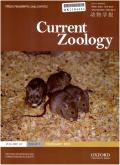Mitogenomics clarifies the position of the Nearctic magpies (Pica hudsonia and Pica nuttalli) within the Holarctic magpie radiation
IF 2
2区 生物学
Q2 ZOOLOGY
引用次数: 0
Abstract
Abstract Partial separation of a peripheral population may lead to its divergence and, potentially, speciation due to genetic drift followed by selection and geographic isolation. This process may cause taxonomic uncertainty because reproductive isolation in allopatry cannot be verified directly. The two Nearctic allopatric species of magpies (Aves, Corvidae: Pica) serve as a good example of these problems. The Black-billed magpie Pica hudsonia is widely distributed in North America, whereas the Yellow-billed Magpie Pica nuttalli is endemic to restricted range in California. Their relationships with Palearctic species have been little studied. We obtained complete mitochondrial genomes of both Nearctic magpie species, along with the Eurasian Magpie (Pica pica) and the Oriental Magpie (Pica serica), 20 mitogenomes in total. Phylogenetic analysis reveals a basal position of P. serica, and P. pica as a sister clade to the two Nearctic species. P. hudsonia and P. nuttalli form reciprocal monophyletic subclades, showing recent divergence between and within them. Our data show that the Nearctic magpie lineage diverged from the common ancestor with P. pica, with a single migration wave via the Beringia. Within the Nearctic, we hypothesize a peripatric mode of speciation among Pica taxa due to divergence and separation of the small marginal population in California below the Sierra-Nevada mountains. Diversifying amino acid substitutions in ND4-ND5-ND6 genes along the branch leading to the New World clade may indicate selection for heat-tolerance. Considering the clear phenotypic differences between P. hudsonia and P. nuttalli, our data, showing their reciprocal monophylies and genetic distinctness, is consistent with the two-species taxonomy.线粒体基因组学澄清了新北极喜鹊(Pica hudsonia和Pica nuttalli)在全北极喜鹊辐射中的位置
外围种群的部分分离可能导致其分化,并可能由于遗传漂变而导致选择和地理隔离而形成物种。这一过程可能导致分类学上的不确定性,因为异种生殖隔离不能直接验证。两种新北极的异域喜鹊(鸟,鸦科:异食鹊)就是这些问题的一个很好的例子。黑嘴喜鹊(Pica hudsonia)广泛分布于北美,而黄嘴喜鹊(Pica nuttalli)则是加州有限地区的地方性喜鹊。它们与古北极物种的关系很少被研究。我们获得了两种新北极喜鹊、欧亚喜鹊(Pica Pica)和东方喜鹊(Pica serica)的完整线粒体基因组,共20个线粒体基因组。系统发育分析表明丝蚕和异食虫是两个新北极物种的姐妹分支。P. hudsonia和P. nuttalli形成相互的单系亚枝,显示出它们之间和内部最近的分歧。我们的数据表明,新北极喜鹊谱系从异食癖的共同祖先分化出来,通过白令陆桥进行了一次迁徙。在新北极地区,我们假设异食兽类群是由于内华达山脉下面的加利福尼亚小边缘种群的分化和分离而形成的一种迁徙模式。ND4-ND5-ND6基因在新世界进化枝上氨基酸替换的多样化可能表明对耐热性的选择。考虑到P. hudsonia和P. nuttalli之间明显的表型差异,我们的数据显示它们的相互单系性和遗传独特性,与两种分类一致。
本文章由计算机程序翻译,如有差异,请以英文原文为准。
求助全文
约1分钟内获得全文
求助全文
来源期刊

Current Zoology
Agricultural and Biological Sciences-Animal Science and Zoology
CiteScore
3.20
自引率
9.10%
发文量
111
审稿时长
6 weeks
期刊介绍:
About the Journal
Current Zoology (formerly Acta Zoologica Sinica, founded in 1935) is an open access, bimonthly, peer-reviewed international journal of zoology. It publishes review articles and research papers in the fields of ecology, evolution and behaviour.
Current Zoology is sponsored by Institute of Zoology, Chinese Academy of Sciences, along with the China Zoological Society.
 求助内容:
求助内容: 应助结果提醒方式:
应助结果提醒方式:


